Nurs 6051 week 7 Study guides, Class notes & Summaries
Looking for the best study guides, study notes and summaries about Nurs 6051 week 7? On this page you'll find 33 study documents about Nurs 6051 week 7.
Page 3 out of 33 results
Sort by
![All exams for NURS 6501 Week (All Weeks) [In Bundle]](/docpics/601fa9bd51ca3_978502.jpg)
-
All exams for NURS 6501 Week (All Weeks) [In Bundle]
- Package deal • 8 items • 2021
-
- $24.49
- + learn more
NURS 6051 Week 2 Quiz 2 Exam (elaborations) NURS 6051 Week 4 Quiz 3 Exam (elaborations) NURS 6051 Week 5 Quiz 4 Exam (elaborations) NURS 6051 Week 6 Quiz 5 Exam (elaborations) NURS 6051 Week 7 PATHO QUIZ 6 NURS 6051 Week 8 Quiz 7 NURS 6501 Week 1 Quiz 8 NURS 6501 Week 3 Quiz
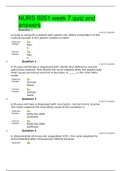
-
NURS 6051 week 7 quiz and answers 2020 latest solution
- Exam (elaborations) • 10 pages • 2020
-
- $14.49
- + learn more
NURS 6051 week 7 quiz and answers Question 11 A nurse is caring for a patient who cannot clot. Which end product of the clotting cascade is this patient unable to make? • Question 2 A 35-year-old female is diagnosed with vitamin B12 deficiency anemia (pernicious anemia). How should the nurse respond when the patient asks what causes pernicious anemia? A decrease in ______ is the most likely cause. • Question 3 A 45-year-old male is diagnosed with macrocytic, normo...
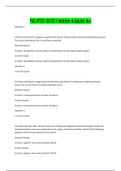
-
NURS 6051WEEK 4 QUIZ A+
- Exam (elaborations) • 10 pages • 2021
-
- $11.39
- + learn more
NURS 6051 Week 4 Quiz 1. A 52-year-old female is diagnosed with coronary artery disease. The nurse assesses for myocardial: 2. While planning care for a patient with superior vena cava syndrome (SVCS), which principle should the nurse remember? SVCS is a progressive _____ of the superior vena cava (SVC) that leads to venous distention of the upper extremities and head. 3. Which organ should the nurse monitor closely since it is often the first to fail in patients with multiple organ dys...
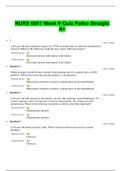
-
NURS 6051 Week 9 Quiz Patho Straight A+
- Exam (elaborations) • 8 pages • 2021
-
- $11.99
- + learn more
NURS 6051 Patho Week 9 Quiz 1. A 30-year-old male presents to his primary care provider reporting visual disturbances. CT reveals a pituitary tumor and lab tests reveal elevated prolactin. He is diagnosed with prolactinoma. Which of the following treatments would the nurse help implement? 2. Visual disturbances are a common occurrence in patients with untreated Graves disease. The endocrinologist explains to the patient that the main cause of these complications is: 3. A 12-year-old mal...
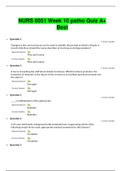
-
NURS 6051 Week 10 patho Quiz A+ Best
- Exam (elaborations) • 9 pages • 2021
-
- $9.99
- + learn more
NURS 6051 Week 10 patho 1. A 30-year-old female with newly diagnosed PCOS is being counseled by her OB-GYN. The physician indicates that this condition often results in: 2. When a staff member asks the nurse what the thick middle layer of the uterine wall is called, what is the nurse’s best response? The: 3. During a routine pelvic exam, a 34-year-old female is found to have an ovarian cyst containing skin, hair, cartilage, and bone. This cyst is classified as a _____ cyst. 4. A 21...
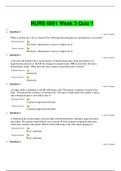
-
NURS 6051 Week 3 QuizA+MATERIAL
- Exam (elaborations) • 6 pages • 2021
-
- $10.99
- + learn more
NURS 6051- Pathophysiology Week 3 quiz 1. When a patient has a fever, which of the following thermoregulatory mechanisms is activated? 2. A 15-year-old male is brought to the ER for treatment of injuries received in a motor vehicle accident. An MRI reveals spinal cord injury, and his body temperature fluctuates markedly. The most accurate explanation of this phenomenon is that: 3. A child presents to his primary care provider with disorientation, delirium, aggressiveness, and stupor. Hi...
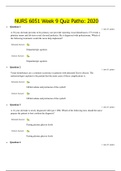
-
NURS 6051 Week 9 Quiz Patho: 2020(Download to Score A+)
- Exam (elaborations) • 11 pages • 2020
-
- $13.99
- + learn more
NURS 6051 Patho Week 9 Quiz 1. A 30-year-old male presents to his primary care provider reporting visual disturbances. CT reveals a pituitary tumor and lab tests reveal elevated prolactin. He is di agnosed with prolactinoma. Which of the following treatments would the nurse help implement? 2. Visual disturbances are a common occurrence in patients with untreated Graves disease. The endocrinologist explains to the patient that the main cause of these complications is: 3. A 12-year-old male is new...
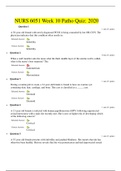
-
NURS 6051 Week 10 Patho Quiz: 2020(Download to Score an A+)
- Exam (elaborations) • 9 pages • 2020
-
- $10.99
- + learn more
NURS 6051 Week 10 patho 1. A 30-year-old female with newly diagnosed PCOS is being counseled by her OB-GYN. The physician indicates that this condition often results in: 2. When a staff member a sks the nurse what the thick middle layer of the uterine wall is called, what is the nurse’s best response? The: 3. During a routine pelvic exam, a 34-year-old female is found to have an ovarian cyst containing skin, hair, cartilage, and bone. This cyst is classified as a _____ cyst. 4. A 21-year-old f...
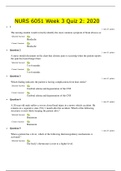
-
NURS 6051 Week 3 Quiz 2: 2020 (Download to Score an A+)
- Exam (elaborations) • 6 pages • 2020
-
- $7.99
- + learn more
NURS 6051 Week 3 Quiz 1. The nursing student would correctly identify the most common symptom of brain abscess as: 2. A 60-year-old female with a recent history of head trauma and a long-term hi story of hypertension presents to the ER for changes in mental status. MRI reveals that she had a hemorrhagic stroke. What does the nurse suspect caused this type of stroke? 3. A 20-year-old male suffers a severe closed head injury in a motor vehicle accident. He remains in a vegetative state (VS) 1 mont...
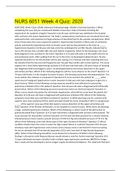
-
NURS 6051 Week 4 Quiz: 2020
- Exam (elaborations) • 2 pages • 2020
-
- $7.99
- + learn more
NURS 6051 Week 4 Quiz 1. A 52-year-old female is diagnosed with coronary artery disease. The nurse assesses for myocardial: 2. While planning care for a patient with superior vena cava syndrome (SVCS), which principle should the nurse remember? SVCS is a progressive _____ of the superior vena cava (SVC) that leads to venous distention of the upper extremities and head. 3. Which organ should the nurse monitor closely since it is often the first to fail in patients with multiple organ dysfunction ...

Did you know that on average a seller on Stuvia earns $82 per month selling study resources? Hmm, hint, hint. Discover all about earning on Stuvia


